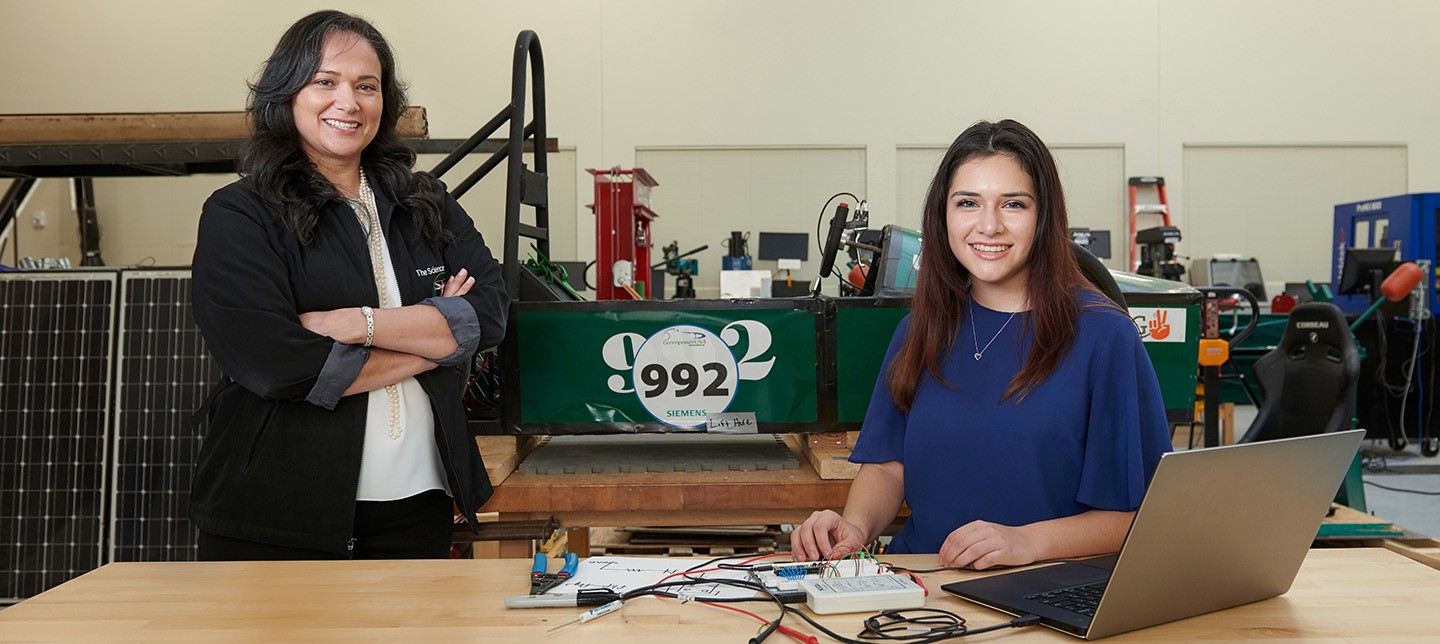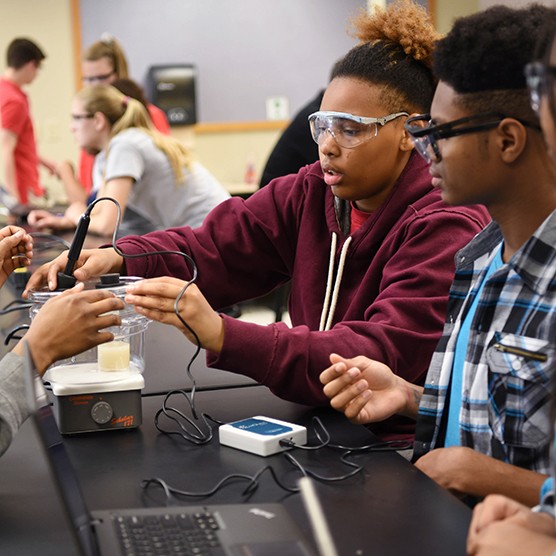
The Next Aerospace Engineers
As we explore the possibilities beyond our atmosphere, we ask, “Who will lead the way?”

As an aspiring engineer and an avid crocheter, 16-year-old Olivia Garcia is a logical thinker who knows how to follow a pattern. Class by class, project by project, she’s pursued her interests and looked for common threads that might reveal her ideal career. After hands-on experiments with laser engraving, 3D CAD modeling software, robotics, and circuit design, she’s landed on a path for her future: designing medical prosthetics.
“I like engineering, and I like the medical field, especially kinesthetics. In my engineering design class, we had to come up with a project to fix something, so I chose how to make prosthetics cooler [less warm for the wearer]. I just fell in love with exploring how they’re made and what new technologies are coming out,” said Olivia.
Olivia Garcia, student at The Science Academy of South Texas, inside the school’s Innovation Lab
An Expansive Education
Olivia was able to get an early immersion in innovative technologies because she attends an innovative school: The Science Academy of South Texas. Located near the U.S.-Mexico border in Mercedes, Texas, the Science Academy serves students from a vast, 3,643-mile area of the Rio Grande Valley. Many students ride the bus for an hour to school each day. They’re drawn by the Science Academy’s ranking as one of the best high schools in the United States and by the opportunity to explore science, math, and engineering through a culture of learning by doing.
You can see this culture in action in Science Academy teacher Nelly Houston’s digital electronics class, where students are working together to build circuits using Multisim Live™. Later they’ll tackle a surprisingly tough challenge: programming breadboards to light up their date of birth using just three switches. It’s a fundamental lesson not only in logic design and electricity but also in collaboration and problem-solving.
One of the things the kids learn is that you fail fast so you can succeed sooner. It’s a cyclical process of making a mistake, figuring out what you’re doing wrong, and asking for help. And once they fix it, they feel so empowered.
a Science Academy alumna who’s now an Engineering
and PLTW teacher at her alma mater
Making Engineering Accessible
Like all Science Academy classes, Ms. Houston’s class is based on curriculum from Project Lead The Way (PLTW), a nonprofit organization that provides PreK-12 students and teachers with hands-on interdisciplinary STEM-based curriculum that uniquely prepares students to thrive in life beyond the classroom.
“The curriculum allows them to learn how to think,” said Lorena Madrigal, assistant principal at the Science Academy. “It’s rigorous and project-based, and they’re learning to collaborate with their peers. We’re very proud those are the skills they’re carrying on into college and the workforce.”
Lorena Madrigal, Assistant Principal at The Science Academy of South Texas
The Science Academy has earned the PLTW distinguished schools designation for two consecutive academic years. The school has a long history with PLTW, with a PLTW Master Teacher from the school contributing to the initial development of the Engineering Design and Development course, one of 10 year-long courses in the PLTW Engineering program. This class asks high school seniors to choose a capstone project that solves a real-world problem. Using the school’s makerspace, students have created pop-up shelters for flash floods, new types of brackets for dental braces, and even more comfortable women’s clothing. Working with a wide variety of tools, from plasma cutters and 3D printers to a stove and refrigerator, shows them that engineering is everywhere.
“I’ve worked on so many interesting projects, from making little racecars powered by CO2 tanks to working a simulated crime scene to help solve an investigation,” said Olivia.
These types of classes provide incredible opportunities for any STEM-minded student, but they’re especially meaningful in this remote region. The Science Academy maintains an open enrollment policy, meaning that any hard-working student in the Rio Grande Valley can attend if there’s room. More than 77 percent of the Science Academy’s students are Latinx and 41 percent are economically disadvantaged—two populations that have been historically underserved by high-quality STEM education. And 99 percent of the Science Academy’s graduates go on to attend college.
With more than 15,000 programs in more than 12,000 schools, PLTW is providing opportunities for brighter futures for all students, including economically disadvantaged and underrepresented populations, by promoting equity, confidence, and achievement in STEM subjects,” said Dr. Vince Bertram, PLTW president and CEO.

Students gain hands-on experience through PLTW’s engineering courses. Image courtesy of PLTW.
Ms. Houston: A Homegrown Role Model
The opportunity to make a difference in her community and explore PLTW’s creative teaching approaches drew Ms. Houston to teach at the Science Academy. She graduated from the Science Academy herself, just a few years after immigrating from Mexico, and went on to build a successful engineering career. In 2007, she was working for a semiconductor test equipment company in Massachusetts when she reconnected with Jeff Hembree, the South Texas Independent School District’s deputy superintendent, who’d been the Science Academy’s principal when she attended.
A few months later, one of Ms. Houston’s favorite teachers from the Science Academy, Mark Schroll, retired. The deputy superintendent called and asked if she’d fill the role. She thought about the impact Mr. Schroll had on her life, empowering her to discover the magic of electricity by building an alarm system.
Ms. Houston moved back to Mercedes with her husband to take the job, becoming a master teacher and the engineering department’s only female faculty member. Ms. Madrigal said that Ms. Houston has been an important role model for girls, from Olivia to her own daughter.
“When my teenage daughter had Ms. Houston as a teacher, she felt more confident. Before that she’d shy away when she was in groups of boys, which make up the majority of our population,” said Ms. Madrigal. “I’m happy to say that my daughter is now finishing her mechanical engineering degree.”
Rudy Medina Jr.: I Bet on Myself
Two hours north of the Science Academy in the coastal city of Corpus Christi, Texas, PLTW’s hands-on classes also helped Rudy Medina Jr. discover his confidence and capabilities.
Growing up in a low-income neighborhood, Rudy didn’t know any engineers. In fact, he didn’t even know what STEM was. What he did know was that he liked going to work with his father, who worked long hours as a jack-of-all trades to support Rudy and his three older sisters. As Rudy shadowed his dad, learning how to do plumbing, construction, and electrical work, he saw it as a way to spend quality time together. Today he sees it differently: “He gave me all the tools I needed to become an engineer.”
Rudy Medina Jr., graduate of the CITGO Innovation Academy
In middle school, Rudy was intrigued by a presentation from the director of the CITGO Innovation Academy at Foy H. Moody High School, a new academy for kids who liked math and science. He decided to apply, despite some teasing from his friends, and was accepted. He immediately took to the school’s classes, which are based on PLTW curriculum.
“It makes education fun, because it challenges you in a way that’s different from your standard learning,” said Rudy. “I got insights into many different STEM fields, from aerospace engineering where I was doing fly calculations to civil engineering where I was using software to construct buildings.” Because he enjoyed both building and programming robots, Rudy ultimately decided he wanted to pursue college degrees in both mechanical engineering and computer science.
Rudy’s parents were determined for him and his sisters to go to college and break the family’s cycle of poverty. But when his dad was laid off toward the end of Rudy’s senior year, Rudy was at a crossroads.
“I thought, do I go into the oilfield or do something else to make some good money right away and start helping my family, or do I bet on myself and try to get a return on investment [from college]?” said Rudy.
Rudy ultimately earned a full-ride scholarship to Texas A&M University-Corpus Christi and decided to bet on himself. The bet paid off. Rudy found the college transition easy because PLTW had trained him so well in fundamental processes.
“I can definitely say that if I hadn’t gone through Project Lead The Way, I would not have been able to double major in computer science and mechanical engineering,” said Rudy.
After graduating from Texas A&M in 2018, he received offers from several Fortune 500 companies and chose a manufacturing engineer position at Texas Instruments because it provided the opportunity to work on both hardware and software.
Rudy Medina Jr. works at Texas Instruments as a manufacturing engineer
Rudy is also passionate about mentoring aspiring engineers through his work with the Society of Hispanic Professional Engineers.
“Growing up, when we’d have guest speakers from the same high school or same background I came from, it opened my eyes. It showed me that if this guy or girl could become an engineer, why can’t I? Now I want to show the same to others like me,” said Rudy.
Rudy added, “I’d recommend Project Lead The Way to every student, even if they don’t have their eye on a STEM career. Learning to think like an engineer is a valuable and marketable skill. And I truly believe that everyone is an engineer in their own way.”
As part of our $3.4 million commitment to advancing diversity in STEM education, NI has awarded Project Lead The Way a grant of $100,000 per year for the next four years. Learn more about PLTW’s mission and NI’s commitment to Changing the Faces of Engineering.